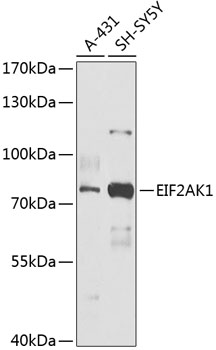-
Product Name
EIF2AK1 Polyclonal Antibody
- Documents
-
Description
Polyclonal antibody to EIF2AK1
-
Tested applications
WB
-
Species reactivity
Human, Rat
-
Alternative names
EIF2AK1 antibody; HCR antibody; HRI antibody; eukaryotic translation initiation factor 2-alpha kinase 1 antibody
-
Isotype
Rabbit IgG
-
Preparation
Antigen: Recombinant fusion protein containing a sequence corresponding to amino acids 371-630 of human EIF2AK1 (NP_055228.2).
-
Clonality
Polyclonal
-
Formulation
PBS with 0.02% sodium azide, 50% glycerol, pH7.3.
-
Storage instructions
Store at -20℃. Avoid freeze / thaw cycles.
-
Applications
WB 1:500 - 1:2000
-
Validations

Western blot - EIF2AK1 Polyclonal Antibody
Western blot analysis of extracts of various cell lines, using EIF2AK1 antibody at 1:1000 dilution.Secondary antibody: HRP Goat Anti-Rabbit IgG (H+L) at 1:10000 dilution.Lysates/proteins: 25ug per lane.Blocking buffer: 3% nonfat dry milk in TBST.Detection: ECL Basic Kit .Exposure time: 60s.
-
Background
Inhibits protein synthesis at the translation initiation level, in response to various stress conditions, including oxidative stress, heme deficiency, osmotic shock and heat shock. Exerts its function through the phosphorylation of EIF2S1 at 'Ser-48' and 'Ser-51', thus preventing its recycling. Binds hemin forming a 1:1 complex through a cysteine thiolate and histidine nitrogenous coordination. This binding occurs with moderate affinity, allowing it to sense the heme concentration within the cell. Thanks to this unique heme-sensing capacity, plays a crucial role to shut off protein synthesis during acute heme-deficient conditions. In red blood cells (RBCs), controls hemoglobin synthesis ensuring a coordinated regulation of the synthesis of its heme and globin moieties. Thus plays an essential protective role for RBC survival in anemias of iron deficiency. Similarly, in hepatocytes, involved in heme-mediated translational control of CYP2B and CYP3A and possibly other hepatic P450 cytochromes. May also contain ER stress during acute heme-deficient conditions (By similarity).
Related Products / Services
Please note: All products are "FOR RESEARCH USE ONLY AND ARE NOT INTENDED FOR DIAGNOSTIC OR THERAPEUTIC USE"
